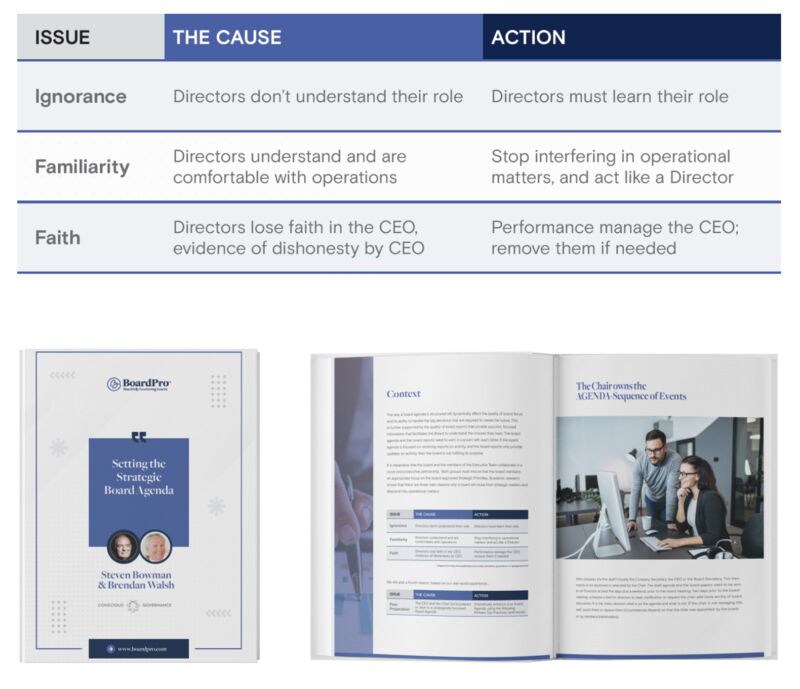Mastering the art of board meetings
Table of Contents
Introduction
The Advantages of a Highly Effective Board Meeting
1. Enhanced Decision Making
2. Improved Efficiency and Productivity
3. Transparent Communication and Collaboration
4. Stronger Governance and Oversight
Preparation is Essential
1. Develop a Board Agenda
2. Building a Strategic Board Agenda
3. Choose a Suitable Space
4. Distribute Relevant Materials
5. Set Clear Expectations
During the Meeting
1. Establish Ground Rules
2.Encourage Discussion and Decision-making
3. Stay on Track
4. Make Decisions and Take Action
5. Maintain Accurate Minutes
Post-meeting
1. Follow up on Action Items
2. Reflect and Assess
3. Communicate Meeting Outcomes
Leveraging Board Portal Software
Conclusion
Ever found yourself drained and disenchanted after a boardroom session, thanks to a staggering array of agenda items or an insurmountable workload? Well if you do then you are in the right place.
Board meetings are the most important part of an organisation's success because they are where important decisions are made, people work together, and plans are made. But if these meetings aren't well planned or run, they can waste time, lead to unproductive conversations, and make it hard to make decisions. This comprehensive guide explains the benefits of effective board meetings, the steps you need to take to get ready for them, the best things to do during the meeting, what to do after the meeting, and why using board portal software is a good idea.
The advantages of a highly effective board meeting
1. Enhanced decision-making
A well-structured and focused board meeting facilitates efficient decision-making. By drafting a comprehensive agenda in advance, the board can address critical issues and prioritise urgent matters.
Input from board members with diverse backgrounds and experiences enriches the decision-making process. Encouraging open dialogue and respectful debate ensures that all viewpoints are taken into account. In the end, better decision-making leads to better strategies, better financial management, and long-term success for the organisation.
2. Improved efficiency and productivity
Effective board meetings offer explicit guidance on tasks, deadlines, and priorities. Board members can focus on problem-solving and new ideas to help the organisation reach its goals when there is a culture of accountability and mutual support. Efficient meetings can also help board members avoid burnout, as they will not be overwhelmed with unnecessary tasks or drawn-out discussions. This will improve the overall productivity and effectiveness of the board and the organisation.
3. Transparent communication and collaboration
Trust is crucial for a board's success. By creating a culture that values open communication and honesty, board members are better able to work together to reach both short-term and long-term goals. With this method, there are no hierarchical divisions within the organisation, so everyone's ideas are given equal weight. Clear communication helps board members avoid misunderstandings and disagreements, which makes it easier for them to work together.
4. Stronger governance and oversight
Effective board meetings lead to stronger governance and oversight within the organisation. When board members are well-informed and involved in making decisions, they are better able to guide and support the executive team. They can also proactively identify potential risks and opportunities, ensuring the long-term stability and success of the organisation.
Preparation is essential
1. Develop an agenda
A well-crafted agenda keeps board meetings on track and ensures that time is used effectively. The agenda should include reports from committees and staff, important decisions, and anything else that needs to be dealt with right away. It is important to be realistic about the number of items on the agenda, and to allocate sufficient time for each topic. Remember to share the agenda with all board members in advance, so they can come prepared with their thoughts and ideas.
2. Building a strategic board agenda
What's the difference between a board meeting agenda and a strategic board agenda?
A board meeting agenda is a list of topics and items that need to be discussed during a regular board meeting. It usually includes items such as reviewing financial statements, approving budgets, discussing operational updates, addressing compliance and regulatory issues, and other routine matters related to the organisation's day-to-day functioning.
On the other hand, a strategic board meeting agenda focuses on the organisation's long-term goals, vision, and direction. It is designed to address and discuss critical strategic issues, such as market positioning, product or service development, competitive analysis, mergers and acquisitions, expansion plans, and other matters that will shape the organisation's future. A strategic board meeting agenda encourages board members to think and act proactively and helps the organization stay on track with its long-term objectives.
In summary, a board meeting agenda covers routine operational matters, while a strategic board meeting agenda delves into long-term planning and strategic decision-making. Both are crucial for an organisation's success but serve different purposes.
The way a board agenda is structured will dynamically affect the quality of board focus and its ability to handle the big decisions that are required to create the future. This is further supported by the quality of board reports that provide succinct, focused information that facilitates the Board to understand the choices they have. The board agenda and the board reports need to work in concert with each other.
If the board agenda is focused on receiving reports on activity, and the board reports only provide updates on activity, then the board is not fulfilling its purpose. It is imperative that the board and the members of the Executive Team collaborate in a close and productive partnership. Both groups must ensure that the board maintains an appropriate focus on the board-approved Strategic Priorities. Academic research shows that there are three main reasons why a board will move from strategic matters and descend into operational matters:
Download our guide - Setting your strategic board agenda
3. Choose a suitable space
Choose a place for board meetings that is appropriate, easy to get to, and comfortable. This will help people work together and reduce distractions. Make sure the place has everything you need, like enough seating, audiovisual equipment, and refreshments. If the meeting is conducted virtually, guarantee that everyone is familiar with the platform and has access to required links and information. Test the technology beforehand to avoid any technical issues during the meeting. Research the most effective way to hold a virtual meeting and strategies to ensure they meet all requirements for all board members, no matter where they are based.
4. Distribute relevant materials
Share all important documents, like committee reports, staff reports, board packs, and background information for decisions that will be made, well before the meeting. Give everyone sufficient time to review the materials and arrive prepared to discuss them. Providing background information and context for each agenda item will help board members to better understand the issues at hand and contribute more effectively to the discussion.
5. Set clear expectations
Before the meeting, communicate the purpose and desired outcomes to all board members. Establish clear expectations for participation, decision-making, and meeting conduct. This will help to create a focused and productive environment where everyone is aligned on the objectives and working towards a common goal.
During the meeting
1. Establish ground rules
At the start of the meeting, review the ground rules to ensure everyone is on the same page. Some of these rules could be about how to participate, how long discussions can last, and how to make decisions. By establishing a clear framework for the meeting, you can prevent misunderstandings and create a more efficient, productive environment.
2.Encourage discussion and decision-making
Ensure that all board members have the chance to speak and that their opinions are valued equally. The final decisions are made by the board as a whole, so it is important to encourage open discussion and healthy debate.
Assign a facilitator or the chairperson to guide the discussion, manage the flow of conversation, and ensure that all voices are heard.
3. Stay on track
Monitor the progress of the meeting to ensure that the agenda is followed and that time is used efficiently. The facilitator or chairperson should be responsible for keeping discussions focused and preventing them from veering off-topic. If necessary, allocate specific time limits to each agenda item and use a timer to stay on schedule.
4. Make decisions and take action
During the meeting, the board should make decisions and take action on key issues. Ensure that any decisions made are clearly documented in the minutes and that specific action items are assigned to individual board members or staff. Establish deadlines and expectations for these action items, and track their progress over time.
5. Maintain accurate minutes
To keep track of who was there, what was talked about, what motions were passed or rejected, and how people voted, it's important to keep accurate records. These records are important for legal reasons and for keeping track of how the organisation is doing in meeting its goals. Assign a designated minute-taker to record the details of the meeting, and ensure that the minutes are reviewed and approved by the board.
Post-meeting
1. Follow up on action items
After the meeting, follow up on action items and allocate responsibilities to specific board and staff members. Set deadlines and offer feedback and guidance when necessary. Regularly check in on the progress of these tasks and provide support to ensure they are completed on time and as expected.
2. Reflect and assess
Take time to evaluate the meeting's effectiveness, pinpointing what worked and what needs improvement. Collect feedback from board members and use it to make any changes you need for future meetings. This process of continuous evaluation and improvement will help to optimise the effectiveness of your board meetings over time.
3. Communicate meeting outcomes
Share the outcomes of the meeting with relevant stakeholders, such as staff, volunteers, and donors. This can help to maintain transparency, build trust, and keep everyone informed about the organisation's progress and direction. Regular communication also helps to create a sense of accountability and fosters a shared commitment to achieving the organisation's goals.
Leveraging board management software
Board management software can substantially boost board efficiency and functionality by streamlining document distribution, facilitating real-time collaboration, and bolstering cybersecurity. Platforms like BoardPro allow board members to concentrate on overarching goals rather than administrative tasks.

Key features of board portal software may include:
- Board pack builder
- Agenda builder
- Document storage and sharing
- Action and task management
- Meeting scheduling
- Voting
- Minute taking
- Decision register
- Interests register
- Board pack annotations
- Circular resolutions (Flying minutes)
- Sub-committees
By adopting board management software, your organisation can save time, reduce the risk of data breaches, and create a more organised, collaborative environment for board meetings.
For organisations to stay on track with their long-term goals, avoid conflicts, and get the oversight they need, they need board meetings that go well. By putting in time and effort to planning, holding, and following up on meetings, you can improve the overall effectiveness of your board and help your organisation succeed. Board portal software can help improve the process even more, making it easier to focus on your goals.
Mastering the art of board meetings involves a combination of thoughtful preparation, focused execution, and thorough follow-up. By following best practices and using technology to your advantage, you can create an environment where board members are able to make well-informed decisions, work together well, and help your organisation succeed.
Remember, continuous improvement is key; learn from each meeting and always strive for better results in the future. With dedication, persistence, and a commitment to excellence, your board meetings will become a powerful instrument in steering your organisation towards its goals and achieving long-term success.
When you're ready here's how BoardPro can help
Start a Free Trial — run a whole board meeting cycle for free, no credit card needed. You’ll be able to create board packs in a click, and have all minutes, decisions, actions and interests in one place. Be more effective, save time, and have everyone on the same page! Book a Demo — see BoardPro in action in this 30-minute demo, and have all your questions answered by a BoardPro specialist. You’ll get an introduction to all of BoardPro’s features — see how to set an agenda, create board packs, and take minutes. Attend a Free Governance Webinar — learn from our community of governance experts on subjects such as strategy, understanding board dynamics, reporting, and running effective meetings. You’ll join hundreds of others in these engaging events covering the latest governance topics. Find a Governance Template — practical documents to make governance easy! Templates cover strategic planning, board evaluation, risk assessment, SWOT analysis, and many other essential governance and business topics to grow your organisation and adopt good governance practices. |
Share this
You May Also Like
These Related Stories

How to run an effective board meeting

How often should a board meet?



